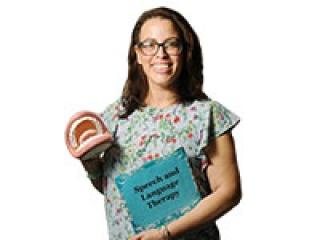Melissa Toribio, a bilingual speech language therapist at PS 531, PS 536 and PS 691 in the Bronx, works to ensure that all her students are able to express themselves and understand others in the classroom and in their daily lives.
What’s the proper title: speech therapist or speech teacher?
I am a speech language pathologist, but I also hold a teaching certificate. I would say speech therapist is the best term, but we have to be able to write lesson plans as well and this is where the teacher aspect comes in.
What are the requirements to be a speech therapist?
Since 2004, when the title and certification requirements changed, speech therapists are New York State-certified teachers of students with speech and language disabilities. The preparation for this certificate requires a master’s degree in speech and language pathology. Most people who complete the master’s degree go on to complete the requirements for a professional license in speech language pathology, which currently requires an additional 36 weeks of supervised clinical experience.
What do people misunderstand about your work?
When people think of a speech teacher, they think about articulation, how children make sounds. Or people think about things such as a lisp or stutter. But language is a big component of our jobs. We work with students who have deficits in attention, memory, problem-solving and other areas. What differentiates us from teachers is that while we provide instruction, we don’t usually follow a curriculum. We’re therapeutic, so we don’t have to follow a certain pace; we work at the student’s pace and can go over skills again and again.
What strategies do you use?
There are many, and they depend on the student and the disorder. But here is an example: when we determine the speech sound we want to focus on, we listen to the sound, discriminate the sound from similar sounds, and then we use something like a puppet or diagram to talk about where the student would make the sound in their mouth — where to put the tongue, the teeth, the lips, the jaw. We practice the sound first in isolation, so maybe it’s the LLL sound. Then we might go to “la,” pairing it with a vowel to move the jaw in a different way. Then we might use vocabulary words. It’s spring, so we might say lamb. Then we might describe the lamb and use the word over and over until the student is able to comfortably use it in phrases, sentences and conversation.
What if you’re working on language?
Let’s say we’re doing a shared reading about spring with a group. One student may be working on following directions, one may be improving vocabulary, one may be working on turn-taking. For the student who’s deficient in vocabulary, it’s helpful to preview that vocabulary and explicitly discuss the words the student needs to focus on. Let’s say we’re identifying farm animals. We might ask where the lamb is and have the student point it out. For the student with difficulty following directions, we might use a visual cue, maybe a checklist. The student with turn-taking difficulties might also benefit from a visual cue. I could place an object in front of the student whose turn it is.
So you typically work in groups?
That depends on the student’s IEP. Group work is more realistic as far as reflecting what’s occurring in the classroom and in real life. If we do need to build skills, we may start out working individually with a particular student and then move the student into a group.
What would you change if you could?
Caseload mandates are very stringent and don’t lend themselves to collaboration. I‘m hoping the DOE will move toward a blended workload model, where we could make time for collaboration in the classroom with the teacher and with occupational and physical therapists. If we had that flexibility, we’d see more student progress.
What’s the biggest challenge?
Scheduling. In elementary schools, we don’t follow the bell schedule. We do eight 30-minute sessions a day and every day is different. I have to take into consideration all the lunch periods, everyone’s preparation schedule and teachers’ preferences at three schools. It’s a fine balance. And therapists are often not provided with adequate work spaces. Many are forced to work in hallways, the back of classrooms and other public and noisy locations. This hinders good therapy and inhibits student progress.
What’s the best part of your job?
Kids become like family. I love seeing them progress. A student I worked with when he was in kindergarten works at the Bronx Zoo now and is graduating from high school. He’s doing amazing. Back then, they wanted to refer him for a special education evaluation because he wasn’t reading or following directions. It took a lot of detective work and a lot of conversations, going into the classroom, looking at his notebook. He was so smart and was doing all these things in therapy, so what was happening in the classroom? I found out he couldn’t see; he had cataracts and he was actually blind in one eye. If I didn’t advocate for him, where would he be now? It’s important to be an advocate.
